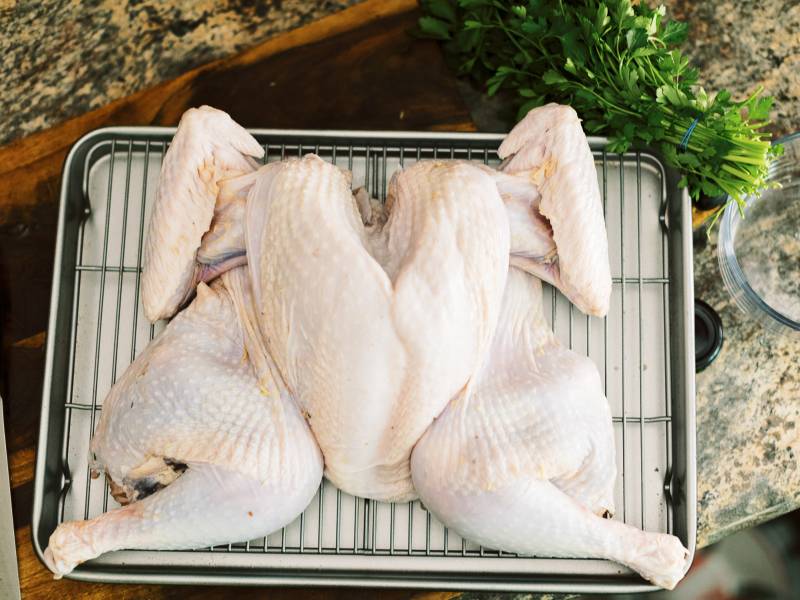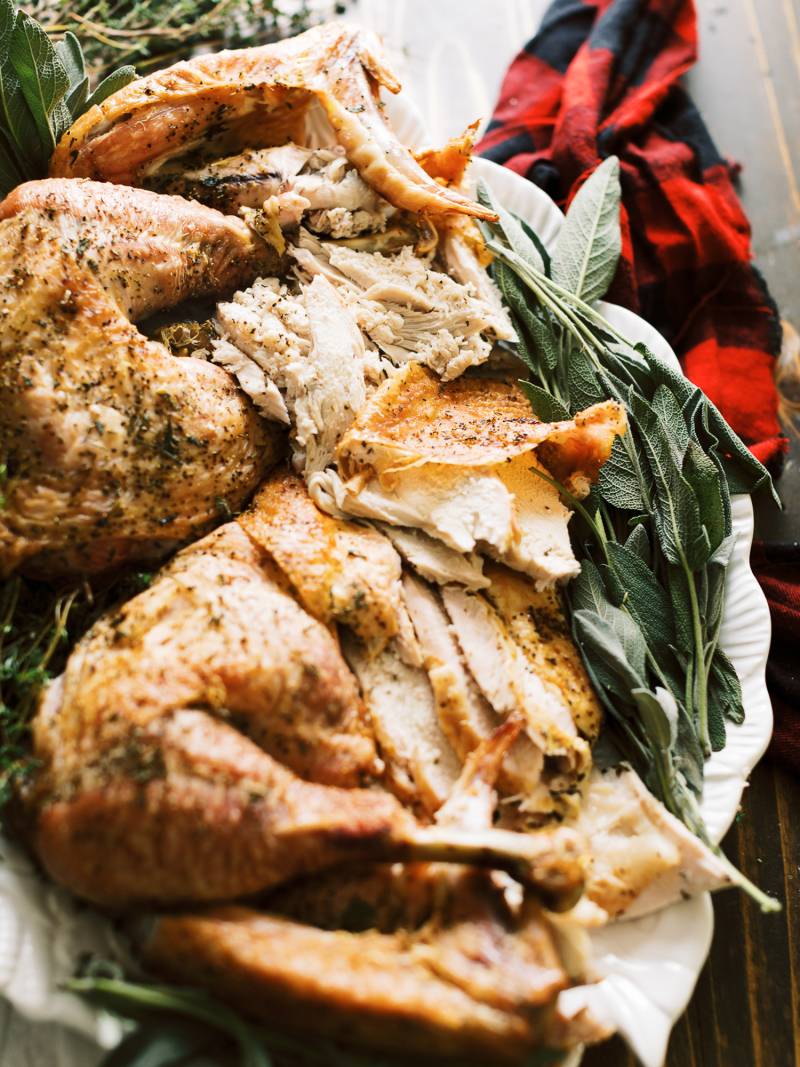It makes sense when you think about how turkeys use their bodies when they’re alive. The white meat is made up of fast-twitch muscles — these aren’t used often but are activated in short bursts. “Those types of muscles are generally low in connective tissue, low in fat and very strong. And what that means is that it’s relatively easy to overcook them,” López-Alt says.
Meanwhile, the dark meat is made up of slow-twitch muscle fibers that the turkey is constantly using when walking around or standing, so the dark meat has a lot of connective tissue — which means you have to cook it at a higher temperature to break it down.
So how to solve this problem rooted in bird biology? Science to the rescue! Read on.
Understand the geometry of your meat, and ditch your roasting pan
“It would be difficult to design a worse tool for roasting a turkey than a roasting pan because you’re taking a problem that already exists and making it even worse,” López-Alt says.
In a roasting pan, the high sides shield the bottom of the turkey — the legs and thighs — from heat, meaning they take longer to cook to temperature. Meanwhile, the breast sticks up over the top of the pan, which means it gets the bulk of the heat and dries out more.
So one simple hack for roasting whole birds is to choose a different kind of pan — a low-rimmed baking sheet with the bird propped on a V-shaped rack. Even better, place the baking sheet on a heated pizza stone. The heat will radiate up through the bottom of the sheet tray and help the thighs and drumsticks cook faster. (Here’s a how-to guide.)
To really solve this dilemma, bring out the poultry shears
Sharma and López-Alt agree that the best way to fix this white meat-dark meat temperature conundrum is to ditch the idea of serving a whole turkey and chop up your bird instead. While it may sound sacrilegious to those who cling to a Norman Rockwell-vision of a Thanksgiving feast, it’s actually the key to a better bird.
 To spatchcock your turkey, you need to remove the backbone and flatten the bird. (Derek Campanile/Dad With A Pan)
To spatchcock your turkey, you need to remove the backbone and flatten the bird. (Derek Campanile/Dad With A Pan)
There are a few ways to go about this: If you’ve got the skills and tools, you can cut your turkey yourself using a technique called spatchcocking — that’s where you remove the backbone so the bird lays flat. (Here’s a helpful how-to from López-Alt.)
Or, if you want to skip the hassle, just ask the butcher to spatchcock the bird for you when you buy it. Sharma notes you can also just buy the turkey cut up in parts.
The whole goal, really, is to get all the turkey parts to lay flat, so the breast and turkey legs and thighs all get the same amount of heat at the same time. The thighs and legs are relatively thin compared with the bulky breast, so they will cook faster. Which is what you want, because that dark meat is going to hit 175 degrees or so just as the breast is getting up to 150 degrees. “So it works out perfectly,” López-Alt says.
Hack the temperature rules for a juicier bird
For food safety, the U.S. Department of Agriculture recommends cooking turkey to an internal temperature of 165 degrees. But at that temperature, López-Alt notes, breast meat will dry out. “Food safety is actually about temperature and time,” he explains. While you’ll kill a bunch of bacteria instantaneously if you cook your turkey to 165 degrees, you can wipe out the equivalent amount of bacteria a little more slowly at 150 degrees — as long as your turkey breast remains at that temperature for at least 3.7 minutes.
Just make sure to let the bird rest before serving it. And make sure to use a food thermometer — don’t rely on just a minutes-per-pound chart, López-Alt says.
Wet or dry, make time to brine
We’ve been focusing on better roasting tips, but of course, you want to brine your bird for maximum tenderness and flavor — something you’ve likely heard many times. “Salt is the most important thing in a brine because that’s what’s adding flavor. It’s what’s helping build moisture inside,” says Sharma.
Sharma explains that normally during cooking, some of the proteins in meat fibers tighten up so that they end up squeezing the juices out of the turkey — like how water gets squeezed out of a sponge. But when you add salt, it loosens up the meat proteins so they hold on to more moisture and your bird stays juicier.
Traditional brines are wet — they involve soaking your meat in a saltwater bath. But López-Alt says this can lead to a bird that, while juicier, is also watery, which can dampen the flavor. He prefers a dry brine, where you rub kosher salt and perhaps herbs and spices on the bird and let it sit in the fridge for a night or two before cooking.
Too lazy to brine? Buy a kosher turkey — these come pre-salted, so they’re essentially already brined.
Even better, try a fermented dairy brine
If you really want to give your turkey a science-based boost this year, Sharma says that based on his kitchen experiments, one brine rules them all: fermented dairy. Think plain yogurt, buttermilk or kefir.
The key here is the lactic acid in these products. Sharma notes that animal muscles synthesize lactic acid on a regular basis, so their cells have evolved mechanisms to regulate how much of this acid they contain. He thinks that is why marinating in lactic acid tends to have a gentler effect on meat — leaving it tender but not mushy. What’s more, dairy is also rich in phosphates, and Sharma says these are even better than table salt at promoting water-binding in meat.
 Spatchcocked turkey, roasted to the right temperature, results in properly cooked thighs and tender breasts. (Derek Campanile/Dad With A Pan)
Spatchcocked turkey, roasted to the right temperature, results in properly cooked thighs and tender breasts. (Derek Campanile/Dad With A Pan)
Sharma, who moved to the U.S. from Mumbai, India, notes that dairy-based marinades are common in Indian and Middle Eastern cooking. “I find that fascinating historically,” he says. “You see that wisdom without the scientific knowledge available today.”
Want to give it a try? Sharma recommends this recipe for buttermilk-brined turkey from cookbook author Samin Nosrat. “It’s pretty fantastic,” he says. (You can also try Sharma’s golden garlic roast turkey recipe.)
Bonus: If you cut up your bird, it’s much easier to brine, wet or dry, because you can just put the meat in plastic bags in your refrigerator, instead of having to clear an entire shelf for a big, whole bird.
Remember: It’s not really about the turkey
If your turkey still turns out a bit subpar, it’s OK. Really. As López-Alt said to me, holiday cooking can be super-stressful, so don’t lose sight of what’s important:
“As long as the turkey has got people around the table, then it’s done its job no matter how dry it is.”




















